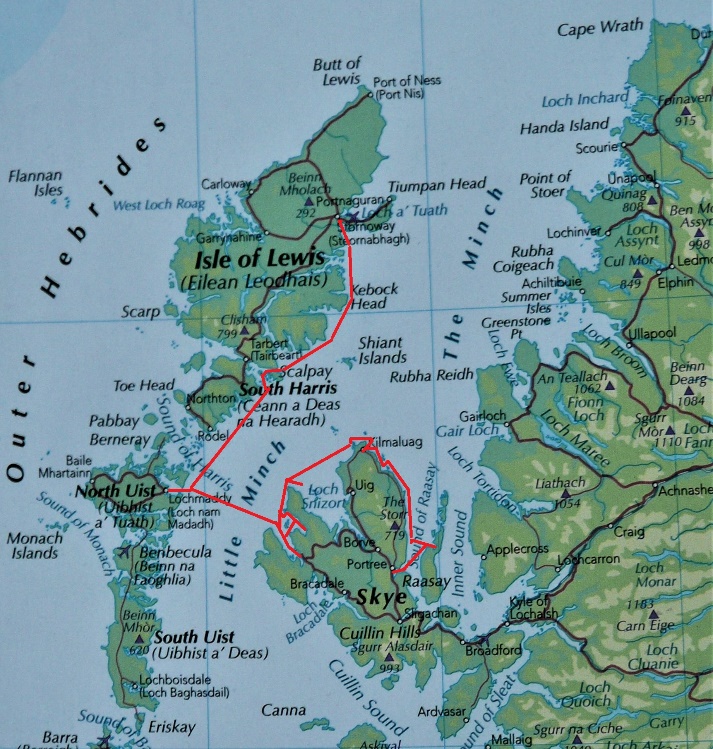 Mixed weather – plenty of wind and rain and not very warm – that is to say, always below
20°. But also some sunshine!
Mixed weather – plenty of wind and rain and not very warm – that is to say, always below
20°. But also some sunshine!
We don’t seem to have done very much sailing during this period – either too much or too
little wind – and also more focus on land activities.
So there we were, stuck in a marina in the bleak outskirts of Stornoway, anxious to get
back further south to be ready for our next rendezvous with friends, but restricted by
Covid, and with adverse winds too strong to battle against. It was a low ebb. However,
after a couple of days a two day window of lighter winds was forecast, before ramping up
strongly again. So, Covid or not we felt we should take advantage of this – making the
50 mile passage in two legs of 5 hours, motoring to conserve our energy. We were hugely
relieved to get back to Lochmaddy, where we relaxed as very strong winds returned,
waiting out Covid before moving on to our next rendezvous. This was a meeting with our
Paddler mates Annie, Norman and Jean, who were camping in Dunvegan in Skye. The passage
across from North Uist to Dunvegan in Skye was just over 20 miles across the Little
Minch – made in increasingly wet conditions.

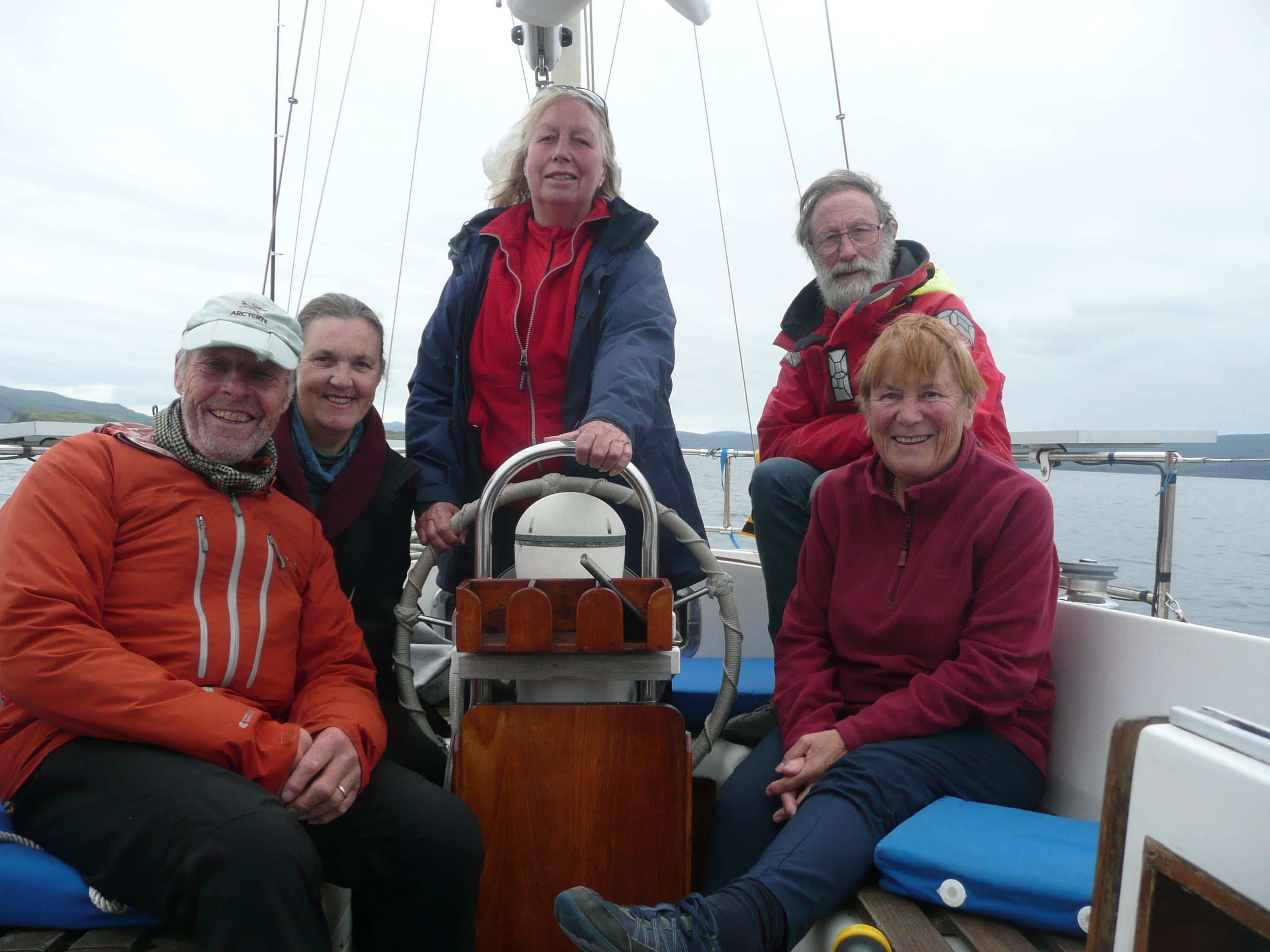
Dunvegan, being 6-7 miles from open sea, is probably the only location on Skye where we
could guarantee shelter in winds from any direction – the perfect location for a week’s
socialising. The weather was unfortunately abysmally wet and windy, and though not the
types to be deterred by adversity, our mates left a day early, before their tent blew
away! However, we did a couple of walks together and hosted a mini-cruise in Aremiti –
out of Loch Dunvegan for a peek into the next loch, then for an overnight stop at anchor
and a visit to the pretty village of Stein. Designed by Thomas Telford in the 1790s as a
fishing village it never took off. Now very upmarket, it boasts a trendy pub, art
gallery and Michelin-starred restaurant with eye-watering prices.
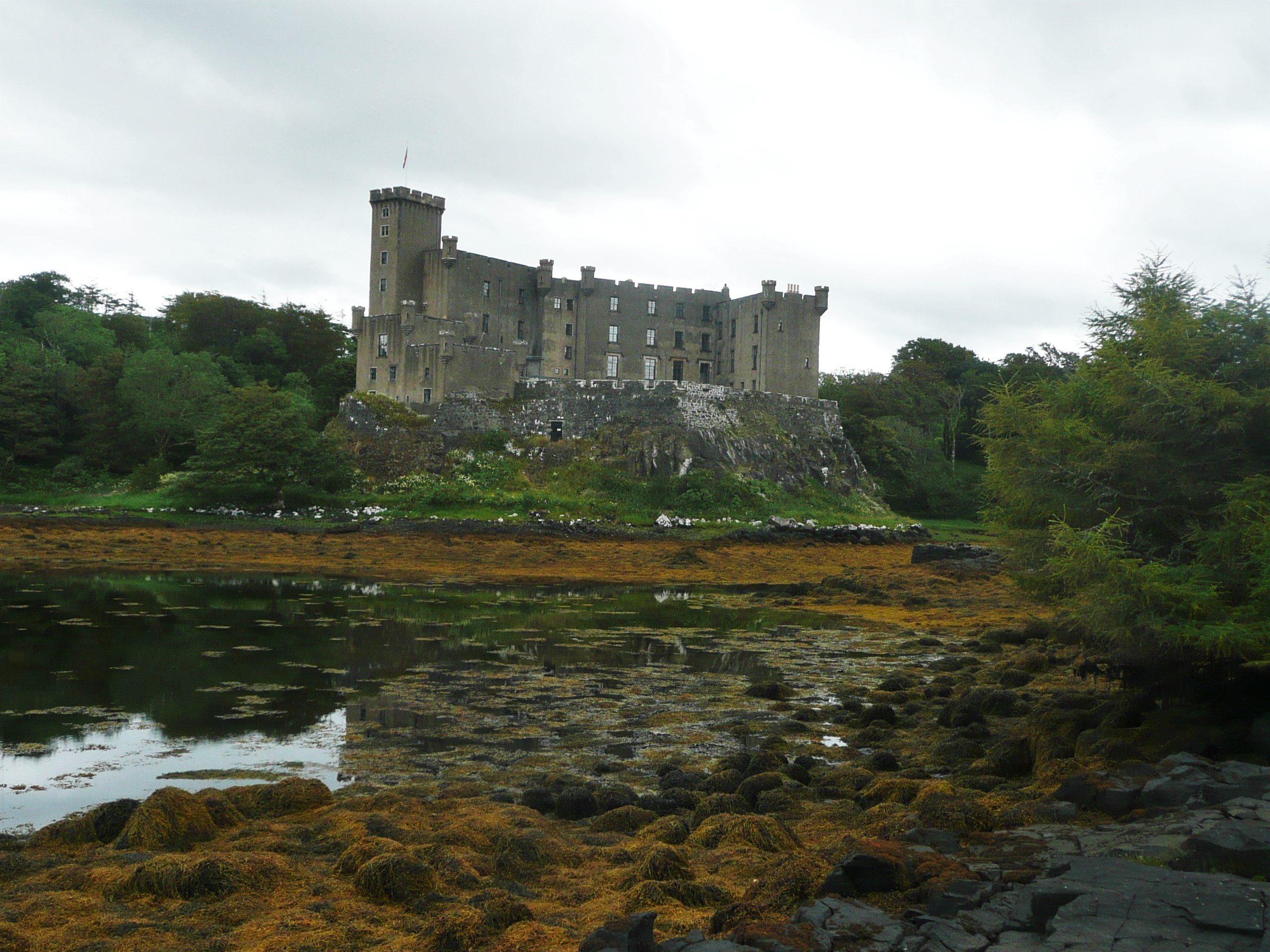
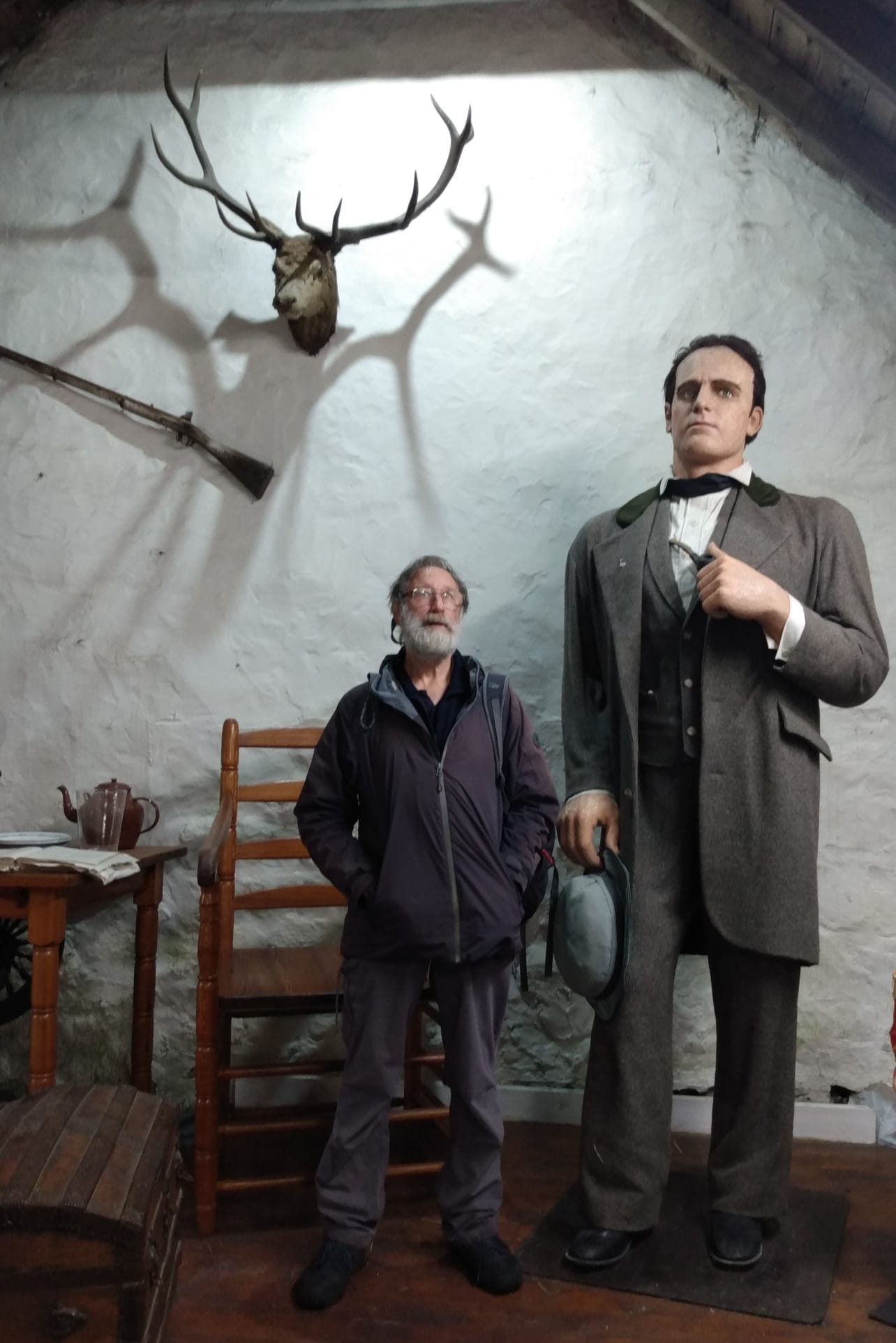 We also visited Dunvegan Castle, seat of the Chiefs of the MacLeod clan now and since the
13th century – astonished to discover that the Chief actually owns the Cuillins!!
Another highlight was the ‘Giant Angus MacAskill’ museum commemorating the life of Angus
(1825-63), considered to be the world's tallest 'true' giant at the extraordinary height
of 7 feet 9 inches. This quirky little museum was created by a distant relative, whose
other – and possibly greater – claim to fame is as the father of the awesome trials
cyclist Danny MacAskill! Terrify yourself with this video of Danny on the Cuillin Ridge.
We also visited Dunvegan Castle, seat of the Chiefs of the MacLeod clan now and since the
13th century – astonished to discover that the Chief actually owns the Cuillins!!
Another highlight was the ‘Giant Angus MacAskill’ museum commemorating the life of Angus
(1825-63), considered to be the world's tallest 'true' giant at the extraordinary height
of 7 feet 9 inches. This quirky little museum was created by a distant relative, whose
other – and possibly greater – claim to fame is as the father of the awesome trials
cyclist Danny MacAskill! Terrify yourself with this video of Danny on the Cuillin Ridge.
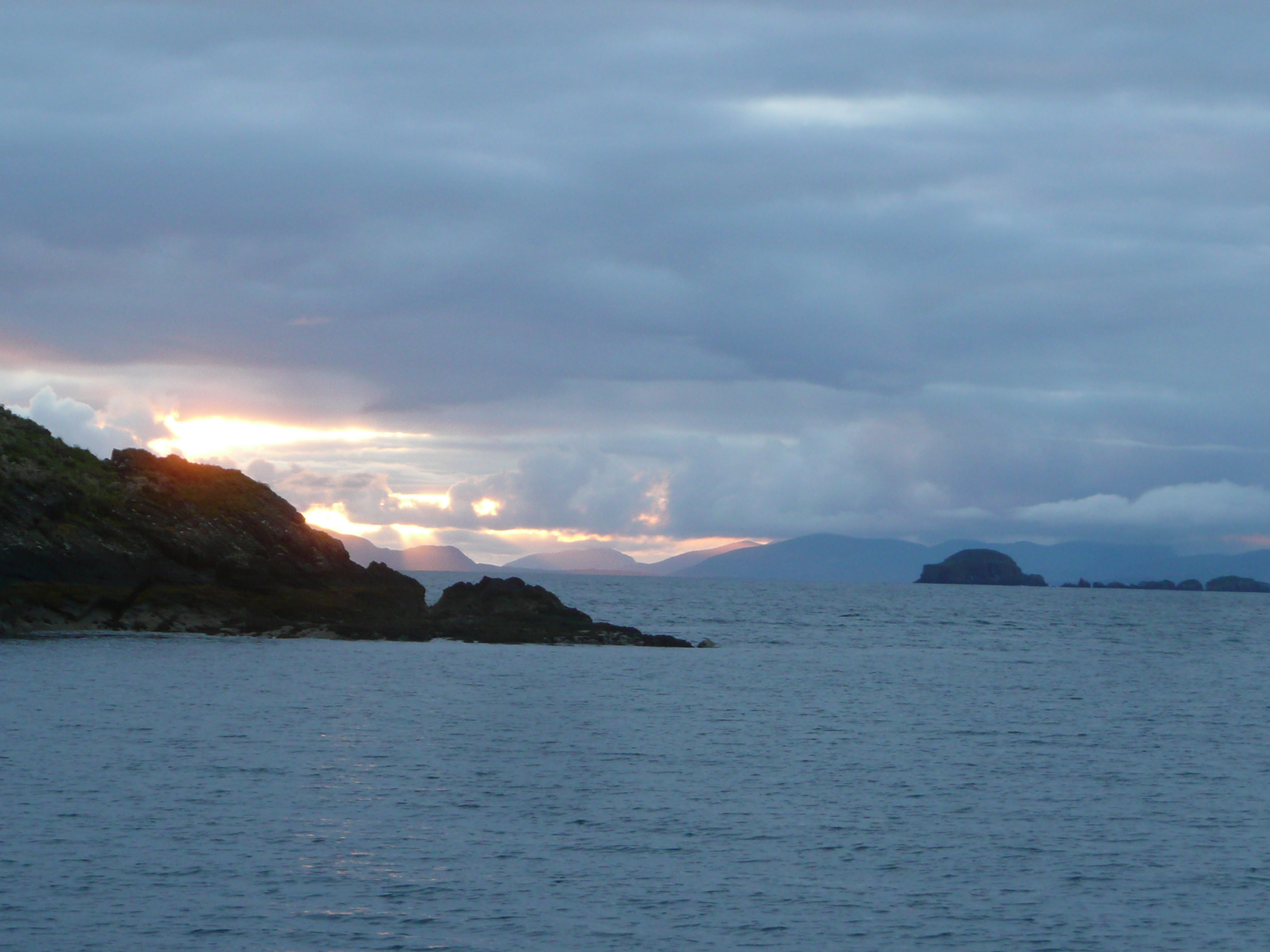 From Dunvegan we
set off to explore more of Skye. No sooner had our friends left than we were treated to
several idyllic days of light winds and sunshine. First stop was Duntulm on the far
north-east tip of Skye – where we spent a beautiful and tranquil night at anchor behind
an island with spectacularly scenic views – a castle, seals, and views back out to the
Outer Hebrides (looking innocently as though they had never heard of wind!). It was
thrilling – and unusual - to enjoy eating and relaxing in the cockpit!
From Dunvegan we
set off to explore more of Skye. No sooner had our friends left than we were treated to
several idyllic days of light winds and sunshine. First stop was Duntulm on the far
north-east tip of Skye – where we spent a beautiful and tranquil night at anchor behind
an island with spectacularly scenic views – a castle, seals, and views back out to the
Outer Hebrides (looking innocently as though they had never heard of wind!). It was
thrilling – and unusual - to enjoy eating and relaxing in the cockpit!
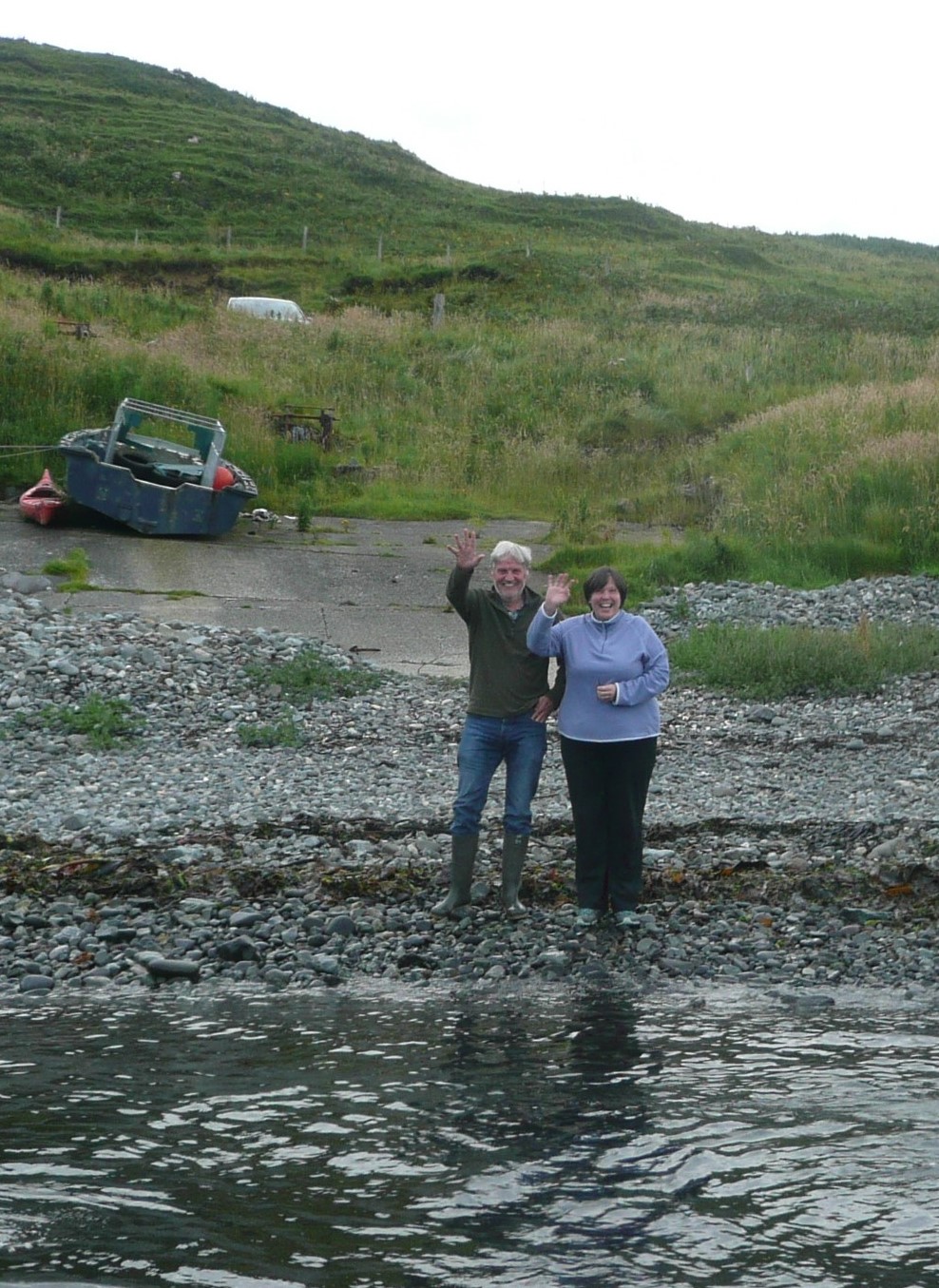
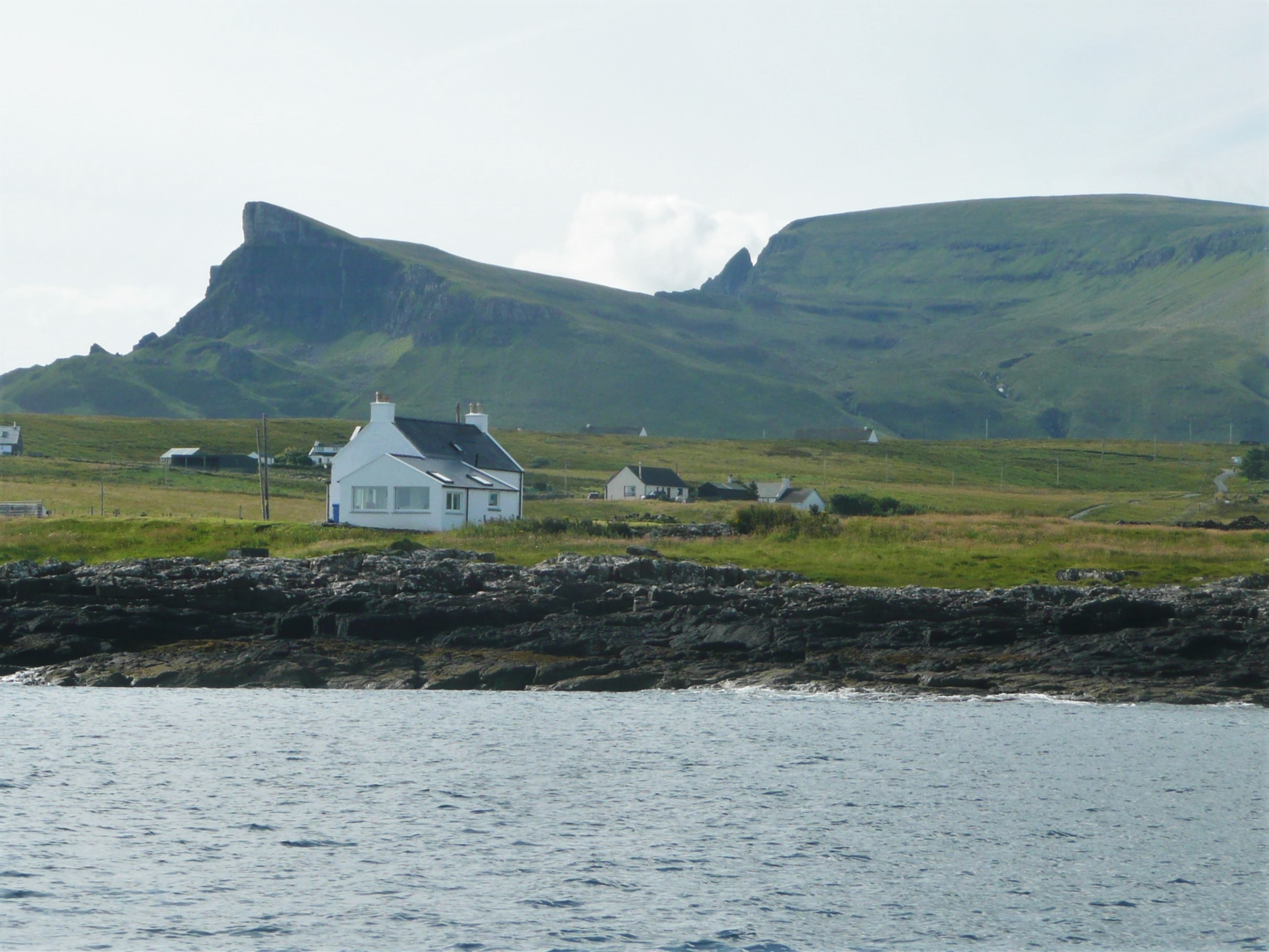 Next stop was at Kilmalaug, just around from Duntulm, passing a stunning coastline, to
rendezvous with new friends. Alex is the daughter of long-ago friends of my parents from
Perth. We had never met – she and one of my brothers have a Facebook relationship and he
put us in touch. She and her architect husband live in a castle near Perth, but also
have a cottage on Skye which they have been renovating. It was delightful to meet them
and not only did they provide very welcome shower facilities, but also a most convivial
evening over a delicious meal! Hopefully we’ll meet again next year.
Next stop was at Kilmalaug, just around from Duntulm, passing a stunning coastline, to
rendezvous with new friends. Alex is the daughter of long-ago friends of my parents from
Perth. We had never met – she and one of my brothers have a Facebook relationship and he
put us in touch. She and her architect husband live in a castle near Perth, but also
have a cottage on Skye which they have been renovating. It was delightful to meet them
and not only did they provide very welcome shower facilities, but also a most convivial
evening over a delicious meal! Hopefully we’ll meet again next year.
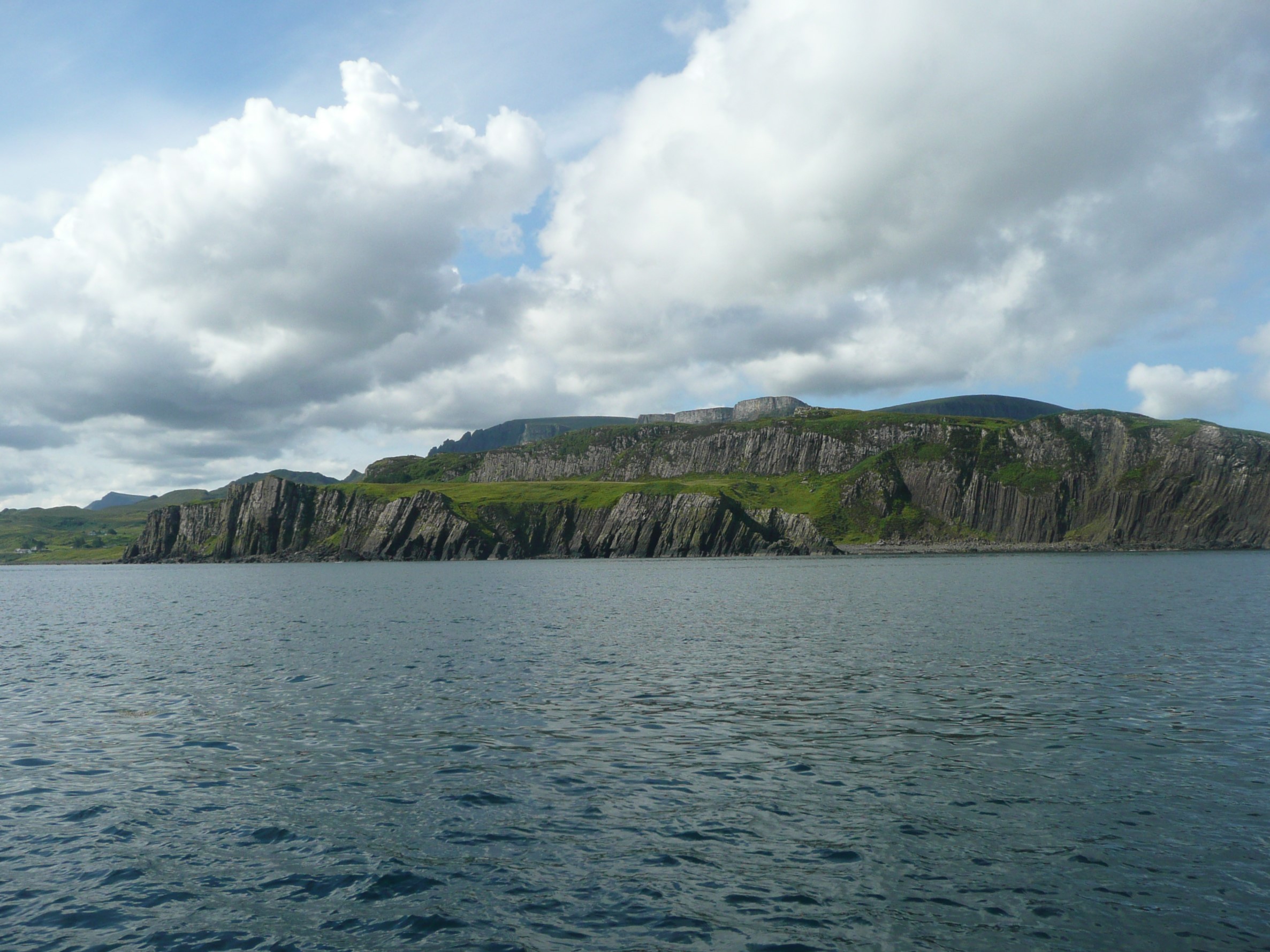 The following day’s passage was one of the most sublime of the summer as we headed south
down the Trotternish Peninsula in beautiful weather. On one side were close views of an
awesomely spectacular chaos of balsaltic cliffs, stacks and escarpments interspersed
with gentle grassy meadows – a landscape on speed. To the northwest were the mountains
of Lewis and Harris, and to the northeast the mountains of the mainland distantly fading
in folds of blue. These misty folds of Scottish mountains and islands tug at the heart –
truly magical and just why we came to Scotland ….
The following day’s passage was one of the most sublime of the summer as we headed south
down the Trotternish Peninsula in beautiful weather. On one side were close views of an
awesomely spectacular chaos of balsaltic cliffs, stacks and escarpments interspersed
with gentle grassy meadows – a landscape on speed. To the northwest were the mountains
of Lewis and Harris, and to the northeast the mountains of the mainland distantly fading
in folds of blue. These misty folds of Scottish mountains and islands tug at the heart –
truly magical and just why we came to Scotland ….
We crossed the glassy waters of the Sound of Raasay to the island of Rona, to anchor in
Arcaseid Mor (Big harbour) with a spectacularly beautiful – and tricky - entrance to the
hidden haven.
 Next, back across to Portree – ‘capital’ of Skye. Recalling our last visit back in 2009
from the south in torrential rain as we entered the harbour, it was bright and cheerful
this time - colourful cottages alongside the harbour and grander villas above. We were
keen to hit the ‘town’ - our first since Mallaig. Larger and more lively than we
remembered, it provided an excellent base for some ‘non-sailing’ activities and also for
catching up with domestic chores. By this stage, we could hardly fail to be aware of the
extraordinary geology of Skye. If you’re interested in geology, Skye is the place to go,
and if not, you could hardly fail to become interested – given such dramatic evidence of
the evolution of the land and coastline.
Next, back across to Portree – ‘capital’ of Skye. Recalling our last visit back in 2009
from the south in torrential rain as we entered the harbour, it was bright and cheerful
this time - colourful cottages alongside the harbour and grander villas above. We were
keen to hit the ‘town’ - our first since Mallaig. Larger and more lively than we
remembered, it provided an excellent base for some ‘non-sailing’ activities and also for
catching up with domestic chores. By this stage, we could hardly fail to be aware of the
extraordinary geology of Skye. If you’re interested in geology, Skye is the place to go,
and if not, you could hardly fail to become interested – given such dramatic evidence of
the evolution of the land and coastline.
50 to 60 million years ago, the breakup of the supercontinent of Pangea led to the North
Atlantic opening up, creating a vast area of volcanic activity which has shaped Skye,
Mull and the other Scottish islands. Successive lava flows overlaid the older rocks to
create the layered mountains, the rugged Cuillins and the columnar basalt formations
seen most notably on Fingal’s Cave on Staffa, the Giant’s Causeway in Northern Ireland
and appearing throughout the islands. Despite subsequent weathering and glaciation, much
of this landscape remains.
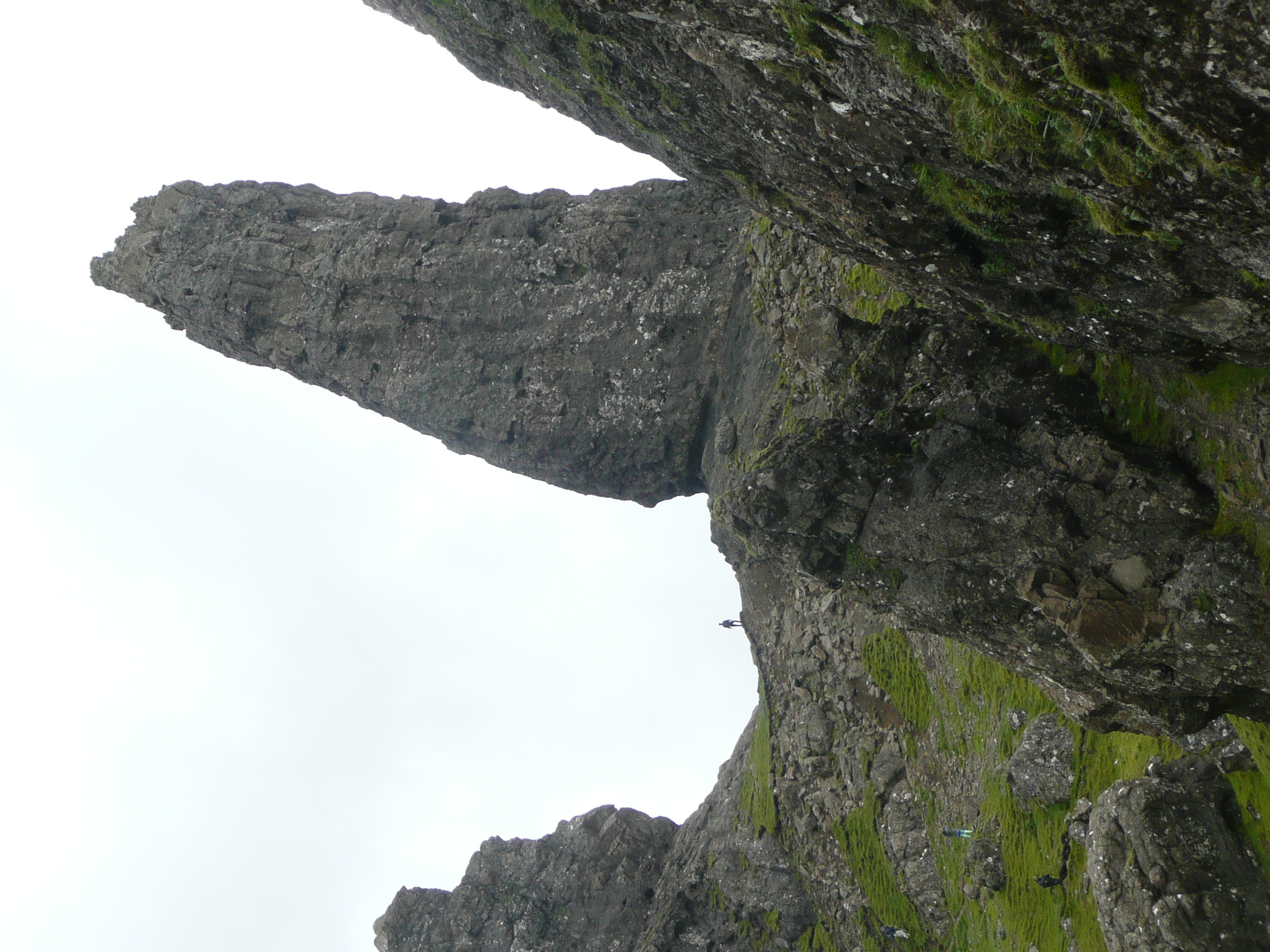 Having been blown away by views of the Trotternish from the sea, we were keen to get in
there by land to explore the detail. This 20 mile escarpment of ancient landslides is
the largest landslide complex in the UK, the weight of the upper volcanic layers having
dislodged the weaker underlying sandstone layers.This complex dates from the period
after the last glaciation, between about 13,000 and 5,000 years ago, following which the
rocks were eroded over time, leaving behind the most resistant parts. We took the local
bus which circulates around the peninsula, along with a large number of other
holidaymakers. We stopped first for a walk to the Storr - on whose slopes the Old Man of
Storr appears precariously positioned. Set at the foot of balsatic cliffs, the Old Man
is the largest of a number of weirdly shaped rock pinnacles, the remnants of ancient
landslips in an area known as the Sanctuary. Ripples in the grassy slopes and rockfalls
are fascinatingly clear evidence of land slippage ….
Having been blown away by views of the Trotternish from the sea, we were keen to get in
there by land to explore the detail. This 20 mile escarpment of ancient landslides is
the largest landslide complex in the UK, the weight of the upper volcanic layers having
dislodged the weaker underlying sandstone layers.This complex dates from the period
after the last glaciation, between about 13,000 and 5,000 years ago, following which the
rocks were eroded over time, leaving behind the most resistant parts. We took the local
bus which circulates around the peninsula, along with a large number of other
holidaymakers. We stopped first for a walk to the Storr - on whose slopes the Old Man of
Storr appears precariously positioned. Set at the foot of balsatic cliffs, the Old Man
is the largest of a number of weirdly shaped rock pinnacles, the remnants of ancient
landslips in an area known as the Sanctuary. Ripples in the grassy slopes and rockfalls
are fascinatingly clear evidence of land slippage …. 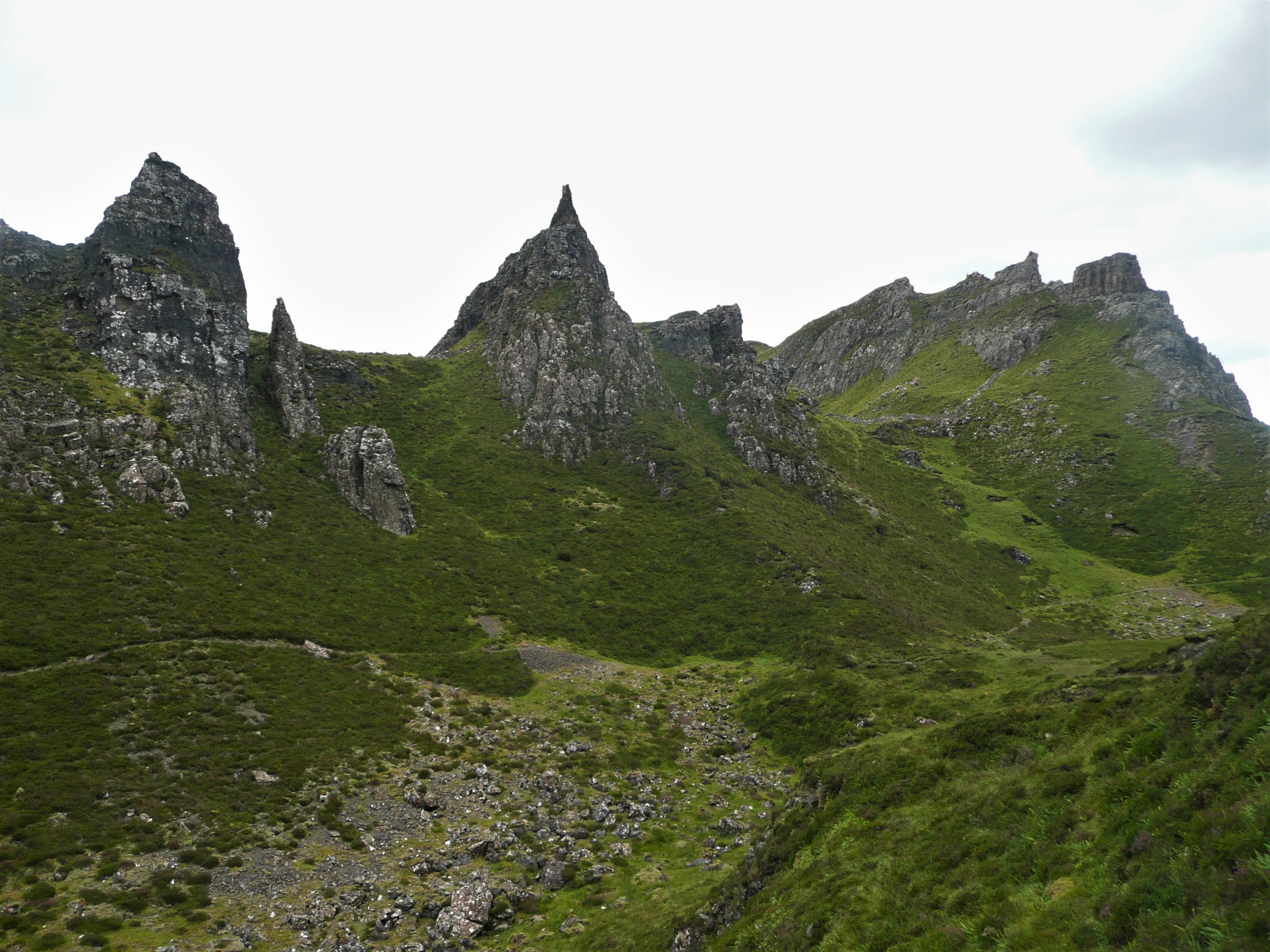 Further north, the Quiraing is a
spectacular series of rock pinnacles, set in a bowl extending over 3 square miles. More
rippled slopes – the area is still active - every year the coastal road below at
Flodigarry has to be repaired due to destruction caused by landslips.
Further north, the Quiraing is a
spectacular series of rock pinnacles, set in a bowl extending over 3 square miles. More
rippled slopes – the area is still active - every year the coastal road below at
Flodigarry has to be repaired due to destruction caused by landslips.
The Cuillin Ranges are one of the most iconic images of Skye. The Black Cuillin Ridge was
formed 60 million years ago – the remains of a huge volcano. Composed mainly of very
hard rough gabbro rock and smoother basalt, they have been shaped by glacial activity to
create the unique jagged ridge, now regarded as the UK’s most challenging mountain
range. The Red Cuillins – rounded and pink - are mainly composed of granite – less
resistant to glaciation.
We had been eagerly anticipating views of them since some very brief but tantalising
glimpses of their jagged peaks many weeks earlier from the island of Rum, and another
distant glimpse from the Outer Hebrides – but mostly they had remained obstinately
hidden from us in deep cloud cover. Now they finally emerged in their full magnificence.

 We enjoyed a superb walk on a perfect day from Glen Sligachan, which divides the two
ranges. Behind were the Red Cuillins and views out to the island of Raasay, and to our
left the spectacular jagged ridge and innumerable noisy waterfalls. Our picnic
overlooked Coire na Creiche, surrounded by awesome peaks - site of the last Scottish
clan battle fought on Skye, when the MacDonalds of Sleat defeated the MacLeods in 1601.
The final highlight of our time in Portree was the local Highland Games. The beautiful
setting on the ‘Lump’ – a promontory overlooking the harbour and Loch Portree - was a
circular green amphitheatre, part natural and part created from a former quarry, against
a background of views through the trees out to the water. The Games were presided over
by the elderly MacDonald Chieftain who strolled around with his special crook observing
the various events. His wishes, expressed in the programme of events - ‘May the weather
be kind and the Midges missing’ - were more or less granted. The wonderful combination
of diverse activities, many taking place concurrently, provided something for everyone –
from the great burly men in kilts competing in the weight-throwing events, to serious
young pipers competing individually before a judge, to young girls performing in the
highland dancing competitions, and athletics events ranging from serious contestants to
the under 12s running race. Several competitors took part in different events – we
watched a high jump competitor who alternated with throwing the hammer – kilt off for
first, then back on for the hammer! The caber throwing proved to be nearly impossible –
only one contestant managed a full toss. The swirl of bagpipes provided a constant
backdrop to all this activity with appearances of the Isle of Skye Pipe Band marching
around the arena. A fabulous day - a stirring, romantic, heart-warming and emotional
atmosphere.
We enjoyed a superb walk on a perfect day from Glen Sligachan, which divides the two
ranges. Behind were the Red Cuillins and views out to the island of Raasay, and to our
left the spectacular jagged ridge and innumerable noisy waterfalls. Our picnic
overlooked Coire na Creiche, surrounded by awesome peaks - site of the last Scottish
clan battle fought on Skye, when the MacDonalds of Sleat defeated the MacLeods in 1601.
The final highlight of our time in Portree was the local Highland Games. The beautiful
setting on the ‘Lump’ – a promontory overlooking the harbour and Loch Portree - was a
circular green amphitheatre, part natural and part created from a former quarry, against
a background of views through the trees out to the water. The Games were presided over
by the elderly MacDonald Chieftain who strolled around with his special crook observing
the various events. His wishes, expressed in the programme of events - ‘May the weather
be kind and the Midges missing’ - were more or less granted. The wonderful combination
of diverse activities, many taking place concurrently, provided something for everyone –
from the great burly men in kilts competing in the weight-throwing events, to serious
young pipers competing individually before a judge, to young girls performing in the
highland dancing competitions, and athletics events ranging from serious contestants to
the under 12s running race. Several competitors took part in different events – we
watched a high jump competitor who alternated with throwing the hammer – kilt off for
first, then back on for the hammer! The caber throwing proved to be nearly impossible –
only one contestant managed a full toss. The swirl of bagpipes provided a constant
backdrop to all this activity with appearances of the Isle of Skye Pipe Band marching
around the arena. A fabulous day - a stirring, romantic, heart-warming and emotional
atmosphere.
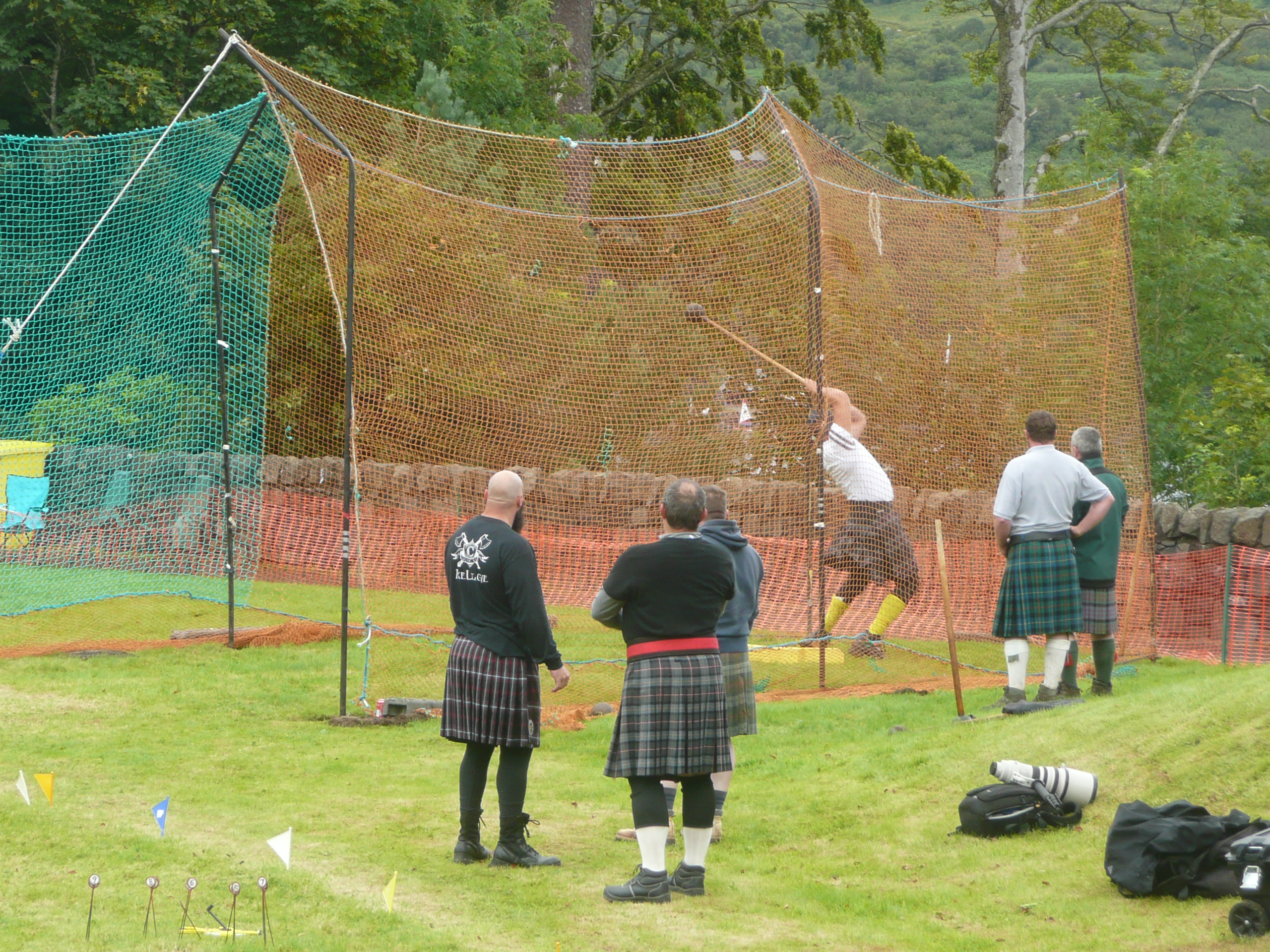
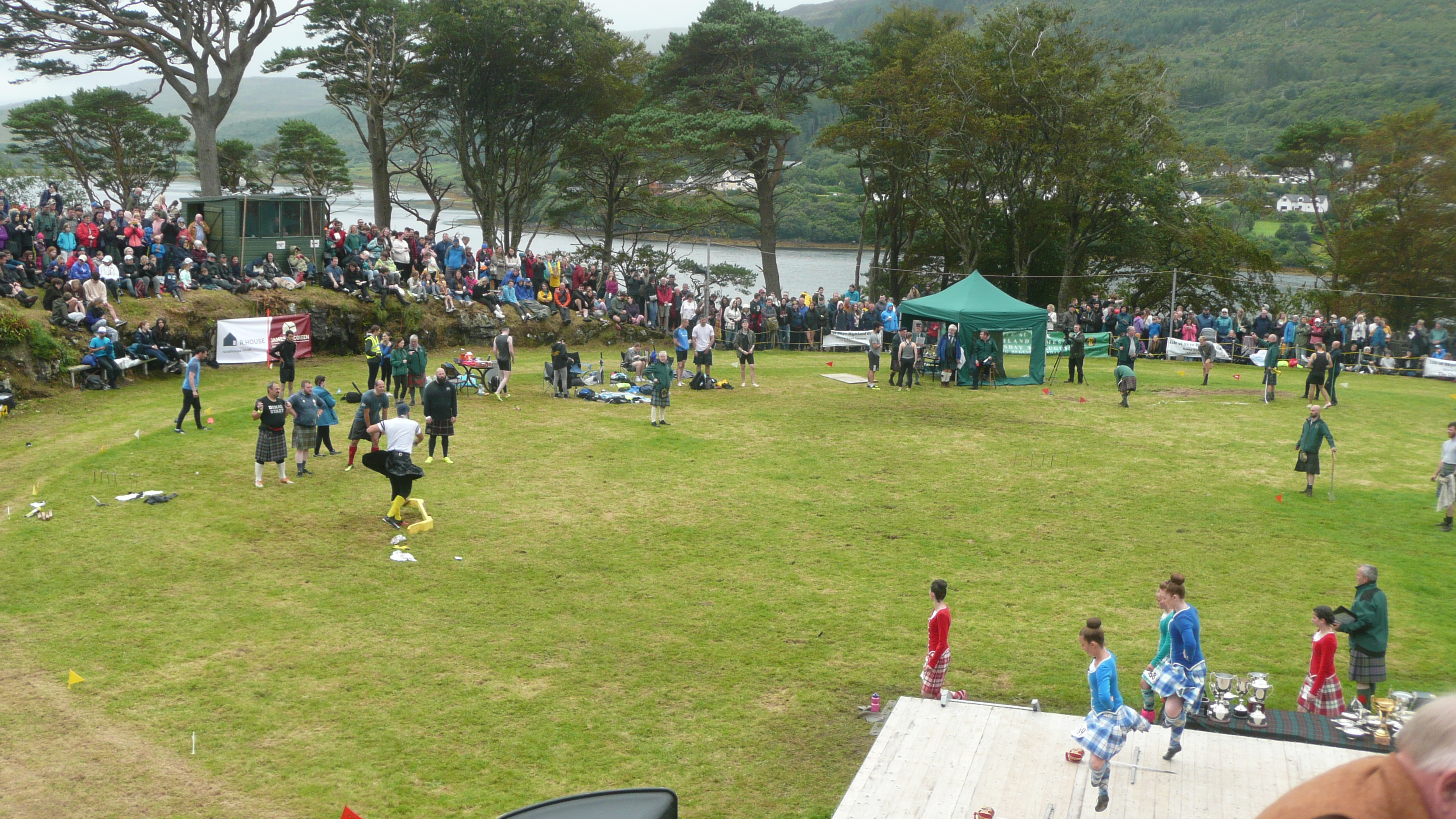
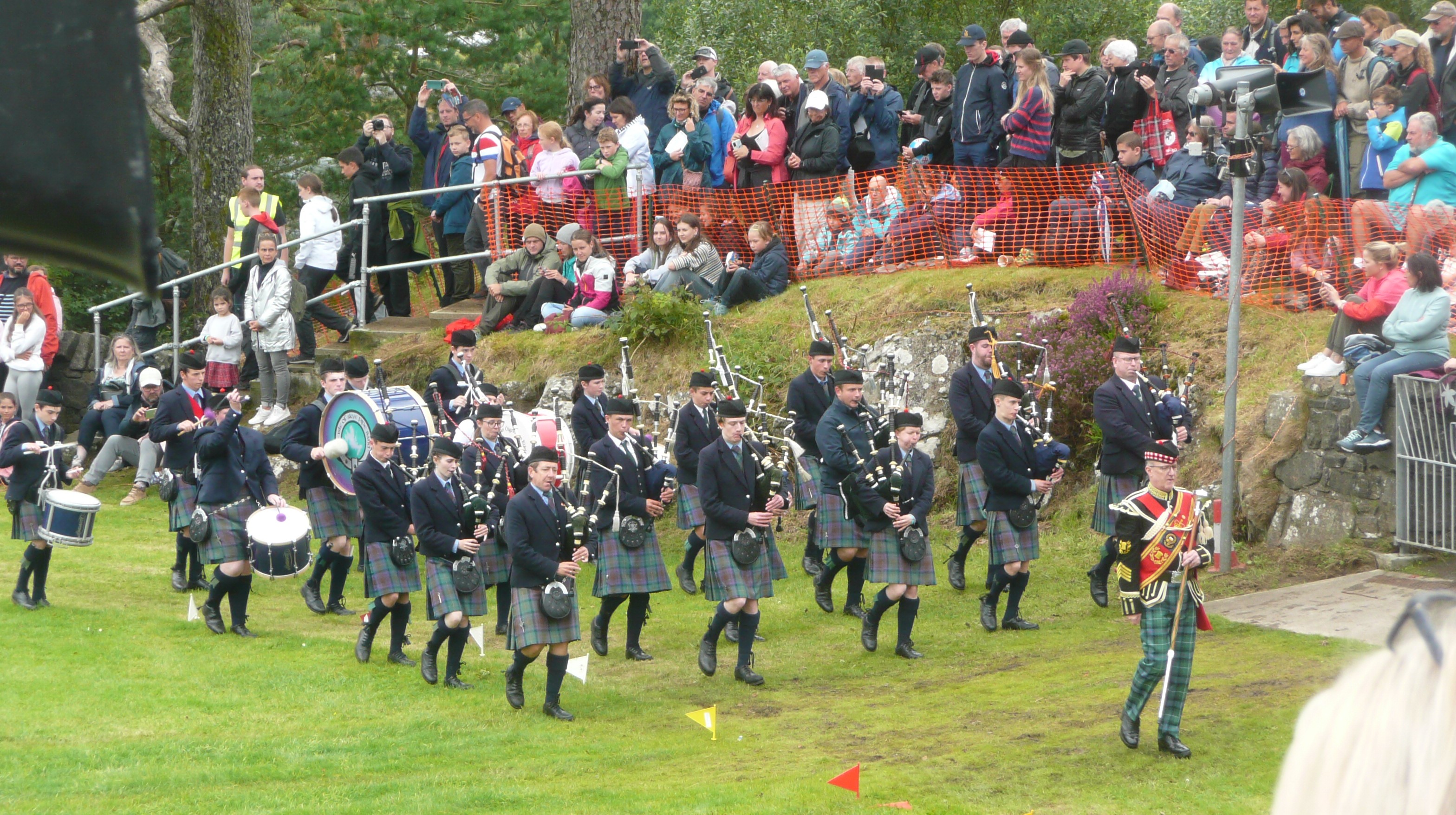
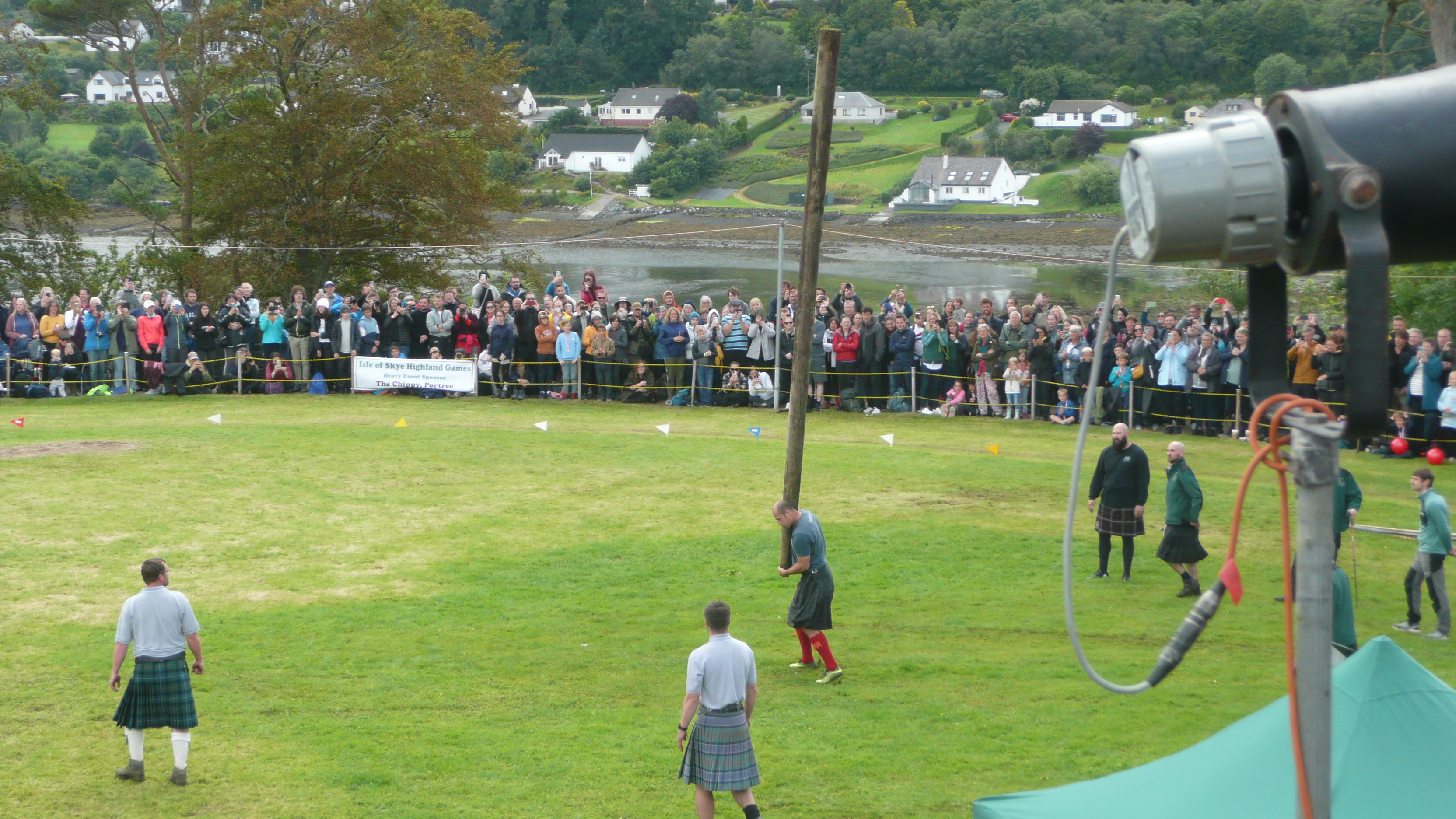

We had a splendid time in Portree – and just to complete the full range of experiences
there, we were also imprisoned on the boat for a day and night with wind so strong and
water so rough that we couldn’t get ashore.
All in all we certainly ended this section of our voyage in very much better spirits than
when we started!
Julia, Chris and Aremiti
 We also visited Dunvegan Castle, seat of the Chiefs of the MacLeod clan now and since the
13th century – astonished to discover that the Chief actually owns the Cuillins!!
Another highlight was the ‘Giant Angus MacAskill’ museum commemorating the life of Angus
(1825-63), considered to be the world's tallest 'true' giant at the extraordinary height
of 7 feet 9 inches. This quirky little museum was created by a distant relative, whose
other – and possibly greater – claim to fame is as the father of the awesome trials
cyclist Danny MacAskill! Terrify yourself with this
We also visited Dunvegan Castle, seat of the Chiefs of the MacLeod clan now and since the
13th century – astonished to discover that the Chief actually owns the Cuillins!!
Another highlight was the ‘Giant Angus MacAskill’ museum commemorating the life of Angus
(1825-63), considered to be the world's tallest 'true' giant at the extraordinary height
of 7 feet 9 inches. This quirky little museum was created by a distant relative, whose
other – and possibly greater – claim to fame is as the father of the awesome trials
cyclist Danny MacAskill! Terrify yourself with this